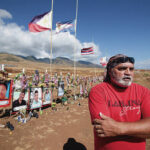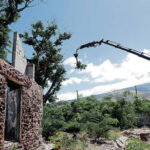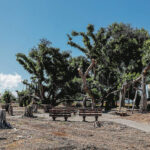Officials sort priorities to devise Lahaina recovery plan




LAHAINA — Sean Corpuel, who lost his popular 1950s-style burger joint, the Cool Cat Cafe, to the Aug. 8, 2023, Lahaina wildfire, has started it up again 45 minutes away in Kihei but one day wants to head back to the future by returning to Front Street.
The same is true for the Cool Cat Cafe’s sister restaurant, the pirate-themed Capt. Jack’s Island Grill, which Corpuel and partners plan to relocate by year’s end to the Sands of Kahana Resort in West Maui.
“Cool Cat was the first Lahaina restaurant to reopen,” Corpuel said. “We definitely want to reopen on Front Street. I’d love to be in the wharf building again, right across from the banyan tree. But it’s so far away; the setbacks and the leases from the landlords (must be worked out), and it could be seven or eight years away.”
It’s been more than a year since the nation’s deadliest fire in more than a century burned Lahaina town to the ground and killed at least 102 people. The U.S. Army Corps of Engineers and its federal, state and local partners as of Wednesday had cleared all of Lahaina’s residential lots, and some homes have begun to emerge from the ashes.
However, USACE and its partners have cleared only 64% of commercial lots, with completion not expected until early 2025. The process is proving slower for the historic and business district, where some properties have to go through additional special management area steps, and there are still deep divides about what the future should look like.
“The strength is the passion of our community. They do not leave it to your imagination. They let you know exactly what they are seeking and what they would like from us,” Maui Mayor Richard Bissen told the Honolulu Star-Advertiser. “When we talk about community-led and government-supported, that’s what that means. So I see our responsibility as taking as many ideas as we can and incorporating it into a plan for the future.”
For many, Lahaina’s more than 150-year-old banyan tree is an important symbol of Maui’s recovery, but disagreement over whether its origin story commemorating the arrival of Christian missionaries should represent the rebuilt Lahaina is an important reminder of the diversity of the community and the complexities surrounding the visioning process. There are economic development teams, land trusts and advisory committees working with government officials to plan a new Lahaina that has access to money that it didn’t before.
Bissen said that’s why the county has emphasized a community-led rebuilding approach to help inform Lahaina’s long-term recovery plan, including a list of projects to address damage from the fire. The diverse views outlined in the recovery plan are meant to guide local, state and federal decision makers, identify and secure funding sources, and move Maui toward greater sustainability and resiliency.
Different priorities
The county is slated to present a draft of the long-term recovery plan to the public for viewing and feedback online and during in-person open houses in late October. Leaders are targeting December for a final plan. A summary of the community’s recommendations are available on the Ola Lahaina page at mauirecovers.org/lahaina.
To get to this point, the county’s Office of Recovery and Planning Department engaged with 3,833 Lahaina residents and interested parties during 11 county activities and events held from September 2023 to July. Feedback was collected from three online surveys and 190 public testimonies and interviews.
More than 900 people participated in five neighborhood workshops that focused on Lahaina’s business and historic districts: Kelawea Mauka, Wahikuli and other areas north and south of Lahainaluna Road.
Neighborhood workshop participants were asked what makes their neighborhood special, what they would want to keep the same and what they would want to change. Survey respondents were asked to rate 19 possibilities for the rebuilding of Lahaina.
All respondents and the neighborhoods that they live in reflected different priorities. For instance, redevelopment opportunities after the fires could provide an opportunity to improve pedestrian access and sewer infrastructure in Wahikuli, which primarily relies on cesspools.
Moving utilities underground was the top first-tier priority in the summary report.
Sea level rise will need to be addressed in Lahaina Town North, which includes Mala, Baby Beach, Keawe Camp and Kupunakea, and Lahaina Town South, which includes Puamana and Shark Pit. There has been heightened and broad interest in redevelopment of Lahaina’s historic and business districts, which make up the core of Lahaina town.
The Department of Planning is working to ease some of the special management area challenges with an expedited exemption process that was launched Sept. 19 for parcels in the Lahaina disaster area. So far, at least 20 exemptions already are in the pipeline.
The perspectives of Kelawea Mauka residents, many of whom live in multigenerational and ethnically diverse households, reflected the challenges they experienced during the fire from narrow streets, compact development and limited evacuation routes.
Lahaina fire survivor Shayne Kahahane, who lives in Kelawea Mauka, wants to see the Lahaina Bypass highway extended north of Lahaina. Kahahane said that its completion would save lives in the future and could have saved some of the 102 people who died during the Aug. 8, 2023, fire, including his older sister, Donna Gomes, 71.
He also supports connecting streets between neighborhoods to improve traffic flow and additional evacuation routes, which was a top-tier priority in the Lahaina Community Engagement Summary Report 2024.
Kahahane wants to see far less priority given to restoring commercial businesses in Lahaina and more focus on increasing green space and public access to water and reconnecting Lahaina to its Hawaiian history and culture.
“Lahaina should become more of an open space for the community, and its ties to Hawaiian history and culture are what’s most important,” Kahahane said. “If there are businesses, they should be local. Lahaina should be for the residents.”
Kekai Keahi also wants to see more green space and more Hawaiian history and culture restored to Lahaina, with an emphasis on incorporating shade trees and other plantings such as native plants and trees — a priority survey takers put at the top of their second-tier concerns.
While the survey did not address Lahaina’s famous banyan tree, Keahi said that “it’s a symbol of colonialism” and should come down because it was planted by people associated with the overthrow of the Hawaiian kingdom. The tree was planted in 1873 to commemorate the 50th anniversary of the arrival of the first Protestant missionaries in Lahaina.
Restoring tradition
Kahahane’s and Keahi’s views were popular among survey respondents, whose second-tier priorities included highlighting Native Hawaiian culture, making Front Street more pedestrian- and cyclist-friendly, and improving shoreline access.
Rebuilding the commercial areas ranked above restoring Mokuula, the former home of King Kamehameha III that was rediscovered under a baseball field at Lahaina’s Maluulu o Lele Park. Those who supported business restoration said West Maui visitors need something to do when they visit and that residents need jobs.
However, Gov. Josh Green, who signed an executive order Aug. 8 returning Mokuula to Lahaina, spoke about the importance of that moment to restoration efforts Sept. 19 during the Council for Native Hawaiian Advancement’s annual convention.
In the earlier days after the fire, Green said he and his wife, Jaime Kanani Green, who is Native Hawaiian, met with Bissen and other stakeholders and “decided that the healing process would be long, but we should start by returning the piko appropriately to the people of Lahaina, and that was to return Mokuula back to the community.”
Green said other champions of Mokuula had been working on the effort since 1962, and the aftermath of the tragedy underscored that “it was the right and the real thing to do.”
He said the decision allows Mokuula to have “its water restored so that that sacred place can be restored and so that in partnership with Jack (Wong, chief executive officer for Kamehameha Schools) and Kamehameha Schools, they can restore the whole ahupuaa right through there and do what has been described by more eloquent speakers than myself: restore tradition, restore land and demonstrate for the world that there are better ways to manage land, that there are opportunities (to mix) modern-day challenges with historic victories and historic wisdom in a way that takes Hawaii forward.”
While Green’s executive order has the Mokuula movement moving forward, a full recovery of Lahaina is a ways out.
Josiah Nishita, county managing director and head of the Office of Recovery, said that based on feedback from other communities that have experienced disasters, “building back a more resilient Lahaina” through long-term recovery projects will take a quite a few years.
Nishita shared the example of Mayfield, Ky., which experienced a devastating tornado three years ago and only this year will break ground on its first post- disaster building. He said Maui County also has sought advice from fire-stricken California communities such as Paradise, Malibu, Sonoma and Santa Rosa, and Boulder, Colo., and communities in Oregon and South Carolina.
“When you look at the progress that we’ve made, we are really proud of it and just very grateful for all the community support and the federal, state and other community partners across the nation,” he said. “(They have) really contributed to helping us really get to where we are today, which is really a lot further along than many people would have thought a long time ago.”
A new era for Lahaina
Money and resources will play a role in how quickly the community’s vision is released, and Bissen said “tie-breaker” priorities will go back to the community for additional vetting.
“If you ask 10 people from Lahaina, you will get 10 different responses about what people want to see. But I think what comes through, I would have to say, is the cultural and the historical nature of that town. The town has experienced different eras from the monarchy to the whaling to the plantation to the tourism era,” he said.
“It’s been through a lot of changes and has adapted, but what that has created are multiethnic traditions and cultures unique to Lahaina. So I would say all of those periods have contributed to what it has evolved into, and this period that we are going through now, I’m sure, we will mark that as well.”
Donna Hartley, who lost her free-spirited little sister, Carole Hartley, 60, to the fire, said Aug. 8, 2023, “should never be forgotten,” and her prayer “is for Maui to recover as quickly as possible.”
Hartley, who lives in Alabama, said her sister had made Lahaina her home for 36 years and was a former dancer with Na Pua o Kapi‘olani Hula Halau, an active member of the Lahaina Canoe Club and a supporter of the town’s annual Halloween celebrations.
Donna Hartley said she too grew to love Lahaina during the 16 visits she made to see her sister and is among those who would love to see Lahaina rebuilt in the style of its historical buildings on Front Street. She also supports erecting a permanent memorial to honor those lost in the fire.
“I would suggest an Aug. 8, 2023, Maui fire concrete wall with all of the names of the fire victims,” Hartley said. “Have a yearly memorial ceremony on the date. I would love to be invited to attend the first historic function.”
Vision quest
Survey respondents, who participated in Maui County’s long-term planning process for Lahaina, were asked to rank 19 options in terms of their importance to Lahaina’s long-term recovery. The scale ranged from 1, unimportant, to 10, extremely important.
Rankings
Tier 1 priorities
— 9.38: Moving utilities underground.
— 9.10: Connecting streets between neighborhoods to improve traffic flow and to provide additional evacuation routes.
— 9.05: Rebuild in a way that prevents the spread of wildfire.
Tier 2 priorities
— 8.94: Incorporate shade trees and other plantings with an emphasis on native plants and trees.
— 8.81: Include affordable rental housing in rebuilding plans.
— 8.72: Highlight Lahaina’s Native Hawaiian culture and Hawaiian history.
— 8.27: Develop a certification program for local contractors to participate in the rebuilding.
Tier 3 priorities
— 8:05: Make Front Street more friendly to pedestrians and cyclists.
— 7.97: Improve public shoreline access.
— 7:94: Rebuild commercial areas.
— 7.92: Restore Moku‘ula, Loko o Mokuhinia, ‘Ulu o Lele (the ulu groves).
— 7.84: Incorporate walking/biking infrastructure into residential neighborhoods.
— 7.78: Encourage industries other than tourism in Lahaina.
— 7.66: Change zoning laws to enable development of diverse housing options at various prices.
— 7.45: Add more green/open space along Front Street.
— 7.01: Provide more public transit options from Lahaina to other destinations in West Maui.
— 6.93: Allow for mixed-use developments that include commercial and residential components.
— 6.89: Add more parking options to the commercial district.
— 6.33: Move buildings away from the shorelines.
To view and download the Maui summary plan, as well as sign up to get notified about future community engagement opportunities, visit mauirecovers.org/lahaina.
Source: Lahaina Community Engagement Summary Report





